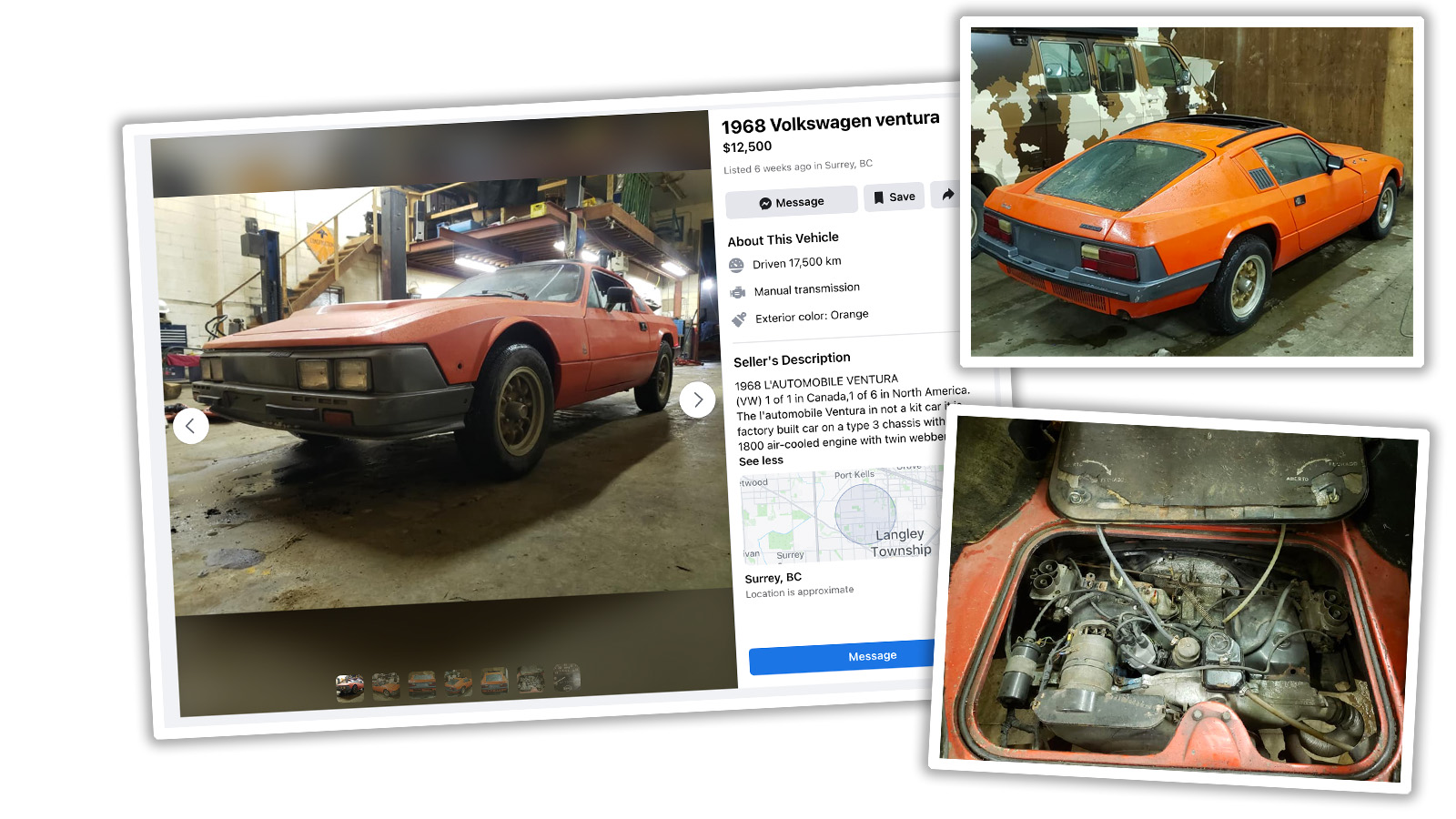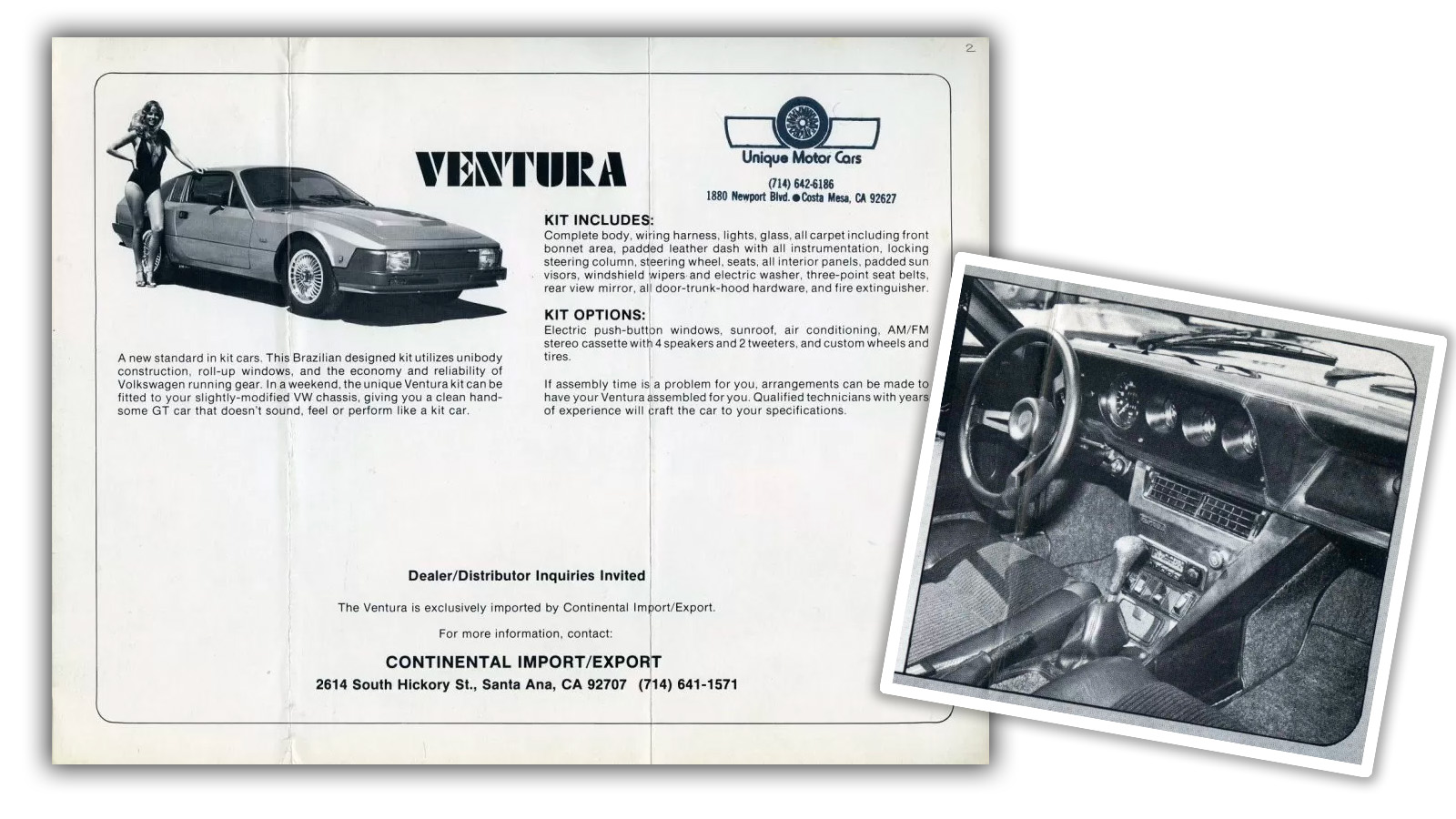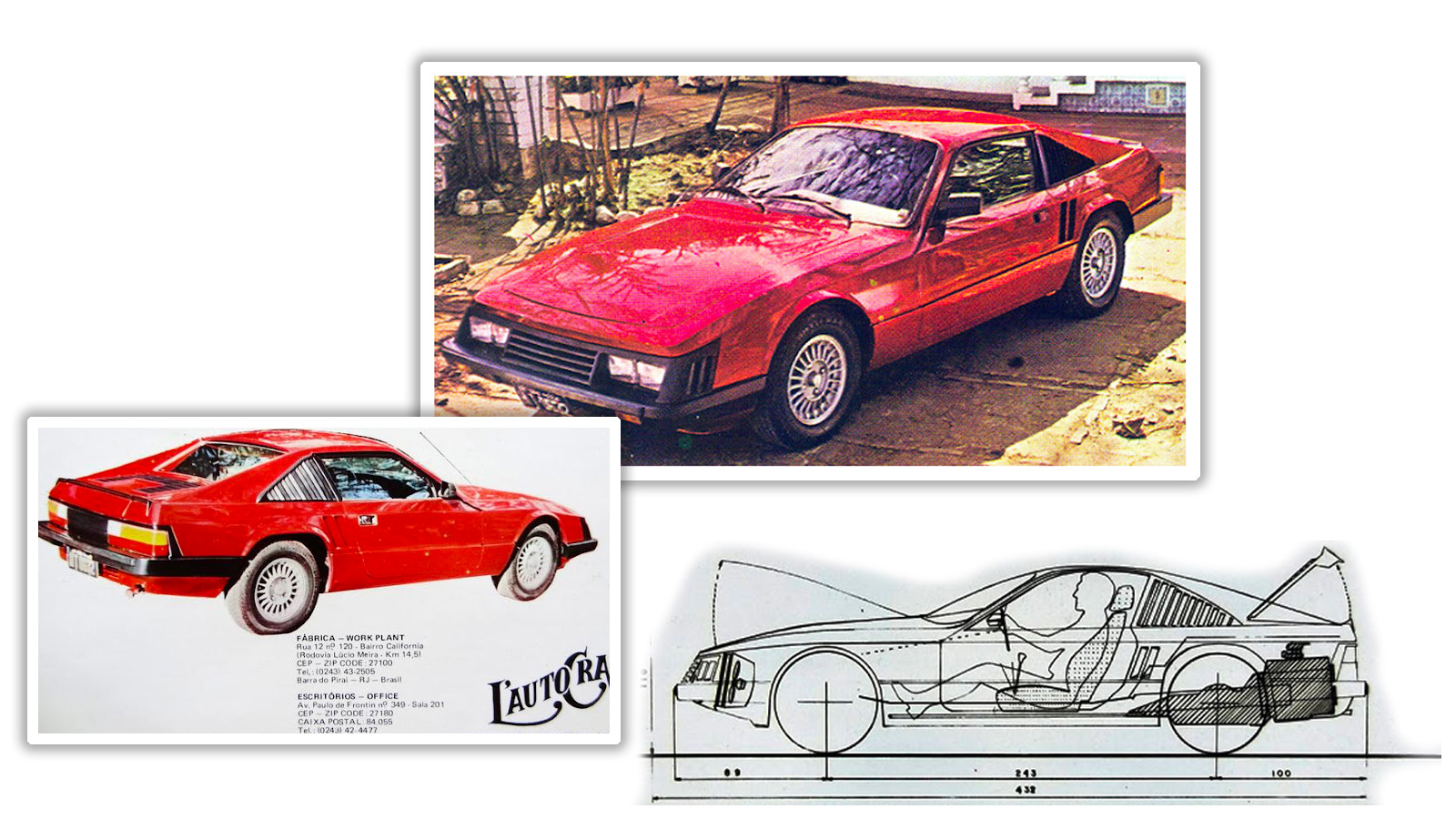One of the first things students of VW kit cars will notice about the Ventura here is that it’s not like most VW-based kit cars, which almost always used the Type I engine: The one found in the Beetle with a tall, tombstone-shaped shroud for the cooling fan. This one uses the Type 3 engine, also known as the “pancake” or “suitcase” engine because it was specifically designed to be as compact as possible, as it lived under the floor of the rear luggage areas on VW Type 3 Fast-, Square-, and Notchbacks. Type 3s were never nearly as plentiful or cheap as old Beetles, so these never really caught on as donor platform for home-built kit cars. And that brings up another interesting point: this looks far too refined to be a home-built kit car.
That’s because it is too refined. Sure, it’s built on a VW chassis, but it wasn’t put together in a backyard. This is a factory-built car that happens to use VW mechanicals. And, if you know much about factory-built VW-based cars not built by Volkswagen, I bet you won’t be surprised to learn that factory was in Brazil. Yes, good old Brazil, a place that was to air-cooled Volkswagens what Australia was to marsupials. The unique nature of the Brazilian automotive market and partially closed economy in the 1970s and 1980s meant that a lot of small companies sprung up to fill automotive niches using readily accessible and reliable VW mechanicals, and L’Automobile Distribuidora de Veículos Ltda. of São Paulo was one such company.
Founded in 1975, the company started making replicas of classics like the Type 35 Bugatti, but based on a VW Brasilia chassis. The Brasilia was essentially a somewhat modernized Beetle with a squared-off, two-door wagon body, and a slightly widened chassis from the VW Karmann-Ghia. Mechanically, it was just like a Beetle, with the Type 1 engine at the rear. The Type 3 engine bolts right up to the VW transaxle just like a Type 1 engine, so Ventura’s use of the wider Brasilia pan with the Type 3 engine was a good, easy choice to maximize the available space for their car; this combination would make a very nice flat, skateboard-type chassis. It was onto this same basic skateboard that Ventura would try their next car, this time not a replica, but instead a modern, sleek sports car with a long hood and a stubby rear, something similar to the sleek VW-based Puma sports cars that had been sold in Brazil for quite a while. Here, someone made a really nice video showcasing a Puma:
The Ventura, introduced at the 1978 National Motor Show in São Paulo, had a more up-to-date look for the late 1970s, with big rectangular headlights from a Dodge Polara and taillights borrowed from an Alfa Romeo GTV.
(brochure scans from Undiscovered Classics) I mean, the thing looked cool! It had that prominent hood power bulge that didn’t do anything from a power perspective, but would have given a couple extra inches of height in the front trunk, which I suppose is just another sort of power. The flat Type 3 engine also permitted a good rear cargo area under a hatch, making these a lot like Volkswagen of Brazil’s own Type 3-powered sports car, the SP-2.
About eight Venturas a month were being built, and some were exported to America, as you can see in that brochure there. You could get them as a kit or pre-built, with options like The look of the interior is clearly above the usual level of fiberglass VW-based kit cars, and looks surprisingly comparable to a lot of other cars of the era, maybe even a little better quality, if you’re comparing to a Triumph TR7 or something. Of course, like all of the fast-looking sports cars holding in air-cooled VW guts, at some point the realization that the looks of the car was writing checks the little 50-ish horsepower flat-four VW engine couldn’t cash would set in. Sometimes companies would just hop up the air-cooled VW engines with twin carbs, more displacement, hotter cams, headers, whatever, but Ventura went down a different path and fitted a 1.6-liter liquid-cooled engine from the VW Passat in 1981. This new Ventura was called the Ventura RS and required a good bit of modification to accommodate the bigger engine, which ate up the cargo room at the rear and the front, since a radiator had to be fitted, which also required a redesign of the front end and more ancillary air intakes on the sides. It’s said that despite all this work, performance didn’t really improve all that much at all, which didn’t help sales. Then, Brazil went into a recession, which forced the company to sell all their inventory and tooling to another company, L’Auto Craft Vehicle Assembler Ltda. Incredibly, with the Passat engine swapped for an Alfa Romeo engine, the Ventura stayed in production until 1990. And, to get back to how all this started, there’s one for sale right now in Canada, for under $10,000 in US dollars, which, I think, seems like a hell of a deal. You’re not going to beat anyone off the line at a stop light, but this is a great-looking and wildly unsual sporty-looking car with a build quality that seems to be a big leap above the usual kit car fare. I hope someone with the resources to restore this fascinating thing picks it up. It’s pretty special. I love it. Still, the decision to use the Type 3 engine in the Ventura due to its more compact size was a good one. The red RS one looks like “Jason asks The Bishop to imagine what a brazillian VW based sport coupe would look like in 1987, if they in an alternate reality had laws about sealed beam headlights as well”. And also a bit like a movie prop. Maybe we could call it the 2000SUX? I don’t understand why more of these didn’t use the Type 4 engine, available from around 1970? It had 80 horsepower, and not the usual 25 to 50 of the old VW Type 1 layout. Since I’m not da Vinci, I would need to stop near the car for any amount of time, and that wouldn’t be always possible – some would get away before I could fetch my notebook, some would be obscured by garage doors, other cars, etc. I think the Ventura was an even more rare occurrence, with me spotting one while on the backseat of a car on traffic. I wasn’t even sure itbat I saw what I thought I saw, until now. It bugged me for a while, until I forgot about it (and about the notebook as well). So, this has been a weird memory lane trip for me 🙂 Thanks Jason!






